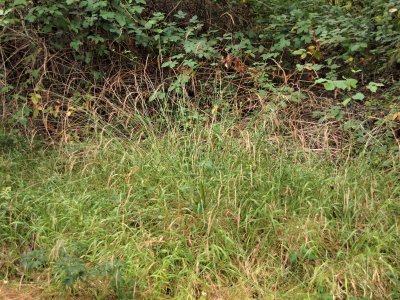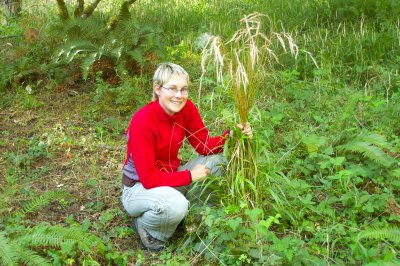 EUGENE, Ore. — (Nov. 15, 2011) — After hiking in Oregon, a University of Oregon plant biologist suggests, people may want to brush off their shoes and comb through their dogs in an effort to curb the spread of an invasive grass that is expanding its range.
EUGENE, Ore. — (Nov. 15, 2011) — After hiking in Oregon, a University of Oregon plant biologist suggests, people may want to brush off their shoes and comb through their dogs in an effort to curb the spread of an invasive grass that is expanding its range.
The grass is false brome (Brachypodium sylvaticum), a native of Europe and Asia, which likely landed in Oregon by way of USDA experimental plots in 1939 near Corvallis and Eugene. This grass likely was brought in, along with other grasses from around the world, to test as a range-improvement crop, but in the test plots the genotypes crossed to create "a little monster" hybrid, according to research published in 2008 by Mitchell Cruzan of Portland State University. The grass escaped and is found today across Oregon, north to south from Astoria to Grants Pass and from west to east from the coast to near Madras, but mostly it is concentrated in the Willamette Valley.
Bitty A. Roy, a scientist in the UO's Institute of Ecology and Evolution, studies the ecology of false brome. In two new studies, Roy and colleagues report that the grass is somewhat controlled in its native Europe by two pathogenic fungi (Claviceps purpurea and Epichoë sylvatica), which block reproduction, but its only known and less-lethal enemies in Oregon are insects.
► AUDIO: Bitty Roy provides an overview of the study
The National Science Foundation-funded research is detailed in separate papers in the journals Ecology and Mycologia. The findings, Roy said, provide support for the "enemy release hypothesis," which says invading plants are free from the enemies of their native habitats. But, she added, they still fall prey to local generalists such as herbivores in the areas they invade.
 |
|
Co-author Aud H. Halbritter with false brome in a natural habitat in Switzerland |
Roy and colleagues studied 10 sites in Oregon and 10 in Switzerland to determine what damages are inflicted on the grass by fungi, insects, mollusk and deer. In Switzerland, they found more kinds of enemies, but the biggest ones were generalist mollusks and the two specialist fungi.
In Oregon, only generalist insects are the enemy. "Generalists can cause a lot of damage, too," Roy said. "We found that this grass actually gets eaten more by insects in its invaded range than it does in its home range."
While such insect damage may slow its growth, false brome now appears to be entrenched among the more than 25 percent of non-native plants now growing across the state, Roy said.
"There has been extraordinary, exponential growth, especially since 1989. The conditions are now perfect to spread, because it has had time to genetically evolve and adapt. We carry things around with us — sometimes accidentally, sometimes on purpose. Then they become our nemeses. This really is a case of 'this is the house that Jack built,'" Roy said, referring to a British nursery rhyme. "Once something gets here, it's really difficult to control it."
False brome also has been confirmed in both Washington state and northern California, the spread of which is monitored by the states' agricultural departments. It has also recently shown up on the East coast. "Grasses are particularly dangerous invaders. They tend to do wholesale ecosystem change," Roy said. Brachypodium sylvaticum grows really well in the shade and in the forests."
Where it grows, it blocks forests' floors, keeping tree seeds from falling to the ground and germinating. It stays green throughout even dry summers. Its impact in encouraging or retarding the spread of wildfires is currently being pursued in controlled burn studies underway by one of Roy's students in a project with the U.S. Forest Service.
There is no easy answer on how to stop the spread, Roy said. Biological control, in which another non-native species is introduced to kill an invasive plan, can backfire, she said, recalling when Oregon agricultural officials imported moths to attack tansy ragwort in the 1970s. Because the ragwort was related to native ragwort, the moths did not discriminate in their attacks and are still found in Oregon today.
For now, she said, being diligent about wiping off clothing and animals after hiking in areas where the grass grows is helpful for reducing spread. She also suggests public participation in special cleanup projects, one of which at Mt. Pisgah, southeast of Eugene, has resulted in a reduction of the grass.
Co-authors with Roy on the Ecology paper were Tobias Policha, Julie L. Stewart and G. Kai Blaisdell, all of the UO's Institute for Ecology and Evolution (IEE), Tim Coulson of Imperial College London, Wilma Blaser of both the IEE and the Institute of Integrative Biology in Switzerland, and Sabine Güsewell, also of the Swiss institute.
Co-authors with Roy on the Mycologia paper were Aud H. Halbritter and Sabine Güsewell, both of the Institute of Integrative Biology in Switzerland, and George C. Carroll of the UO Institute for Ecology and Evolution.
About the University of Oregon
The University of Oregon is among the 108 institutions chosen from 4,633 U.S. universities for top-tier designation of "Very High Research Activity" in the 2010 Carnegie Classification of Institutions of Higher Education. The UO also is one of two Pacific Northwest members of the Association of American Universities.
Media Contact: Jim Barlow, director of science and research communications, 541-346-3481, jebarlow@uoregon.edu
Source: Bitty A. Roy, associate professor of biology, 541-346-4520, bit@uoregon.edu
Additional Link:
OSU Extension information: http://extension.oregonstate.edu/gardening/node/952